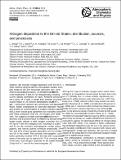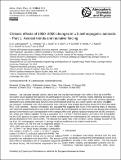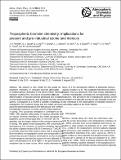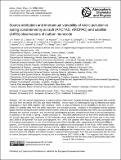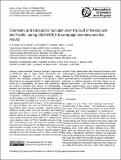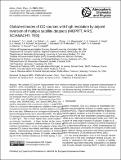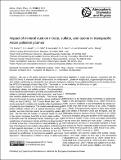Search
Now showing items 11-20 of 287
Nitrogen Deposition to the United States: Distribution, Sources, and Processes
(European Geosciences Union, 2012)
We simulate nitrogen deposition over the US in 2006–2008 by using the GEOS-Chem global chemical transport model at 1/2°×2/3° horizontal resolution over North America and adjacent oceans. US emissions of NOx and NH3 in the ...
Climatic Effects of 1950-2050 Changes in US Anthropogenic Aerosols - Part 1: Aerosol Trends and Radiative Forcing
(European Geosciences Union, 2012)
We calculate decadal aerosol direct and indirect (warm cloud) radiative forcings from US anthropogenic sources over the 1950–2050 period. Past and future aerosol distributions are constructed using GEOS-Chem and historical ...
Riverine source of Arctic Ocean mercury inferred from atmospheric observations
(Springer Nature, 2012)
Methylmercury is a potent neurotoxin that accumulates in aquatic food webs. Human activities, including industry and mining, have increased inorganic mercury inputs to terrestrial and aquatic ecosystems. Methylation of ...
Tropospheric Bromine Chemistry: Implications for Present and Pre-Industrial Ozone and Mercury
(European Geosciences Union, 2012)
We present a new model for the global tropospheric chemistry of inorganic bromine (Bry) coupled to oxidant-aerosol chemistry in the GEOS-Chem chemical transport model (CTM). Sources of tropospheric Bry include debromination ...
The United States' Next Generation of Atmospheric Composition and Coastal Ecosystem Measurements: NASA's Geostationary Coastal and Air Pollution Events (GEO-CAPE) Mission
(American Meteorological Society, 2012)
The Geostationary Coastal and Air Pollution Events (GEO-CAPE) mission was recommended by the National Research Council's (NRC's) Earth Science Decadal Survey to measure tropospheric trace gases and aerosols and coastal ...
Source Attribution and Interannual Variability of Arctic Pollution in Spring Constrained by Aircraft (ARCTAS, ARCPAC) and Satellite (AIRS) Observations of Carbon Monoxide
(European Geosciences Union, 2010)
We use aircraft observations of carbon monoxide (CO) from the NASA ARCTAS and NOAA ARCPAC campaigns in April 2008 together with multiyear (2003–2008) CO satellite data from the AIRS instrument and a global chemical transport ...
Chemistry and Transport of Pollution over the Gulf of Mexico and the Pacific: Spring 2006 INTEX-B Campaign Overview and First Results
(European Geosciences Union, 2009)
Intercontinental Chemical Transport Experiment-B (INTEX-B) was a major NASA (Acronyms are provided in Appendix A.) led multi-partner atmospheric field campaign completed in the spring of 2006 (http://cloud1.arc.nasa.gov/intex-b/). ...
Global Estimates of CO Sources with High Resolution by Adjoint Inversion of Multiple Satellite Datasets (MOPITT, AIRS, SCIAMACHY, TES)
(European Geosciences Union, 2010)
We combine CO column measurements from the MOPITT, AIRS, SCIAMACHY, and TES satellite instruments in a full-year (May 2004–April 2005) global inversion of CO sources at 4°×5° spatial resolution and monthly temporal resolution. ...
Correlations between Fine Particulate Matter \((PM_{2.5})\) and Meteorological Variables in the United States: Implications for the Sensitivity of \(PM_{2.5}\) to Climate Change
(Elsevier, 2010)
We applied a multiple linear regression (MLR) model to study the correlations of total \(PM_{2.5}\) and its components with meteorological variables using an 11-year (1998–2008) observational record over the contiguous US. ...
Impact of Mineral Dust on Nitrate, Sulfate, and Ozone in Transpacific Asian Pollution Plumes
(European Geosciences Union, 2010)
We use a 3-D global chemical transport model (GEOS-Chem) to interpret aircraft observations of nitrate and sulfate partitioning in transpacific dust plumes during the INTEX-B campaign of April–May 2006. The model includes ...


